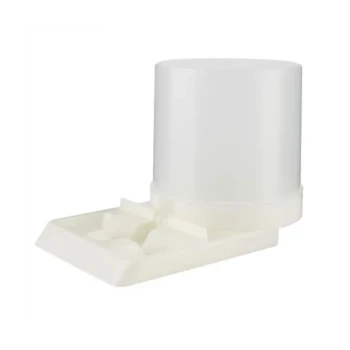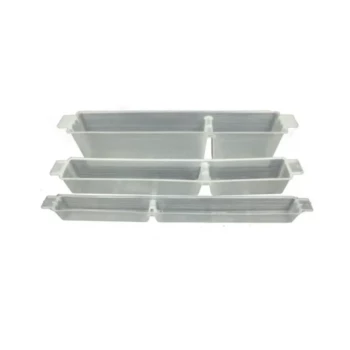In beekeeping, a nucleus colony, or "nuc," is a small, self-contained honey bee colony. Unlike a package of loose bees, a nuc is essentially a miniature, fully-functioning hive, complete with a laying queen, worker bees, and frames of brood, honey, and pollen, making it a complete starter unit for a new beehive.
A nucleus colony provides a significant head start for a new hive by delivering an already established social structure and brood cycle. The core decision is not about which is "better," but which starting point—an established nursery or a larger but less developed population—aligns with your immediate goals and management capacity.

What Constitutes a Nucleus Colony?
A nuc is more than just a box of bees; it is a functioning ecosystem in miniature. Understanding its components reveals why it's such a popular method for starting a new hive.
The Core Components
A standard nuc typically consists of three to five deep frames within a small, portable box. These frames contain all the elements of a healthy, growing colony.
The three inner frames are typically dedicated to brood in all stages of development—eggs, larvae, and capped pupae. This proves the queen is fertile and actively laying.
The two outer frames serve as the pantry, containing stored honey for energy and pollen for protein to feed the developing brood.
A Miniature, Functioning Hive
Crucially, a nuc includes a mated, accepted, and actively laying queen. Her pheromones have already organized the bees into a cohesive social unit, eliminating the risk of queen rejection that can occur when introducing a new queen to a package of bees.
This pre-established structure means the colony is already performing all essential tasks: foraging, nursing the young, and building comb.
Nuc vs. Full-Size Colony: The Key Differences
While a nuc and a full-size Langstroth colony use the same standard-sized frames, their initial state and management needs are distinct.
Frame Count and Physical Size
The most obvious difference is size. A nuc holds 3-5 frames, whereas a standard full-size Langstroth hive box holds 8-10 frames.
This means a full-size colony starts with a much larger population and more developed resources from day one.
Initial Growth Trajectory
A nuc has a "running start." Because it already contains frames of brood, the colony's population is set to expand exponentially as soon as those new bees emerge.
A full-size colony, if started from a package, must build comb and wait for the queen to begin laying before its population can grow. A nuc bypasses this initial setup phase.
Understanding the Trade-offs
Choosing between a nuc and a more established colony involves weighing the benefits of a head start against the need for rapid management intervention.
The Advantage of a "Head Start"
The primary advantage of a nuc is its stability. You receive a proven queen and an established brood pattern, which significantly reduces the risk of a new colony failing to thrive.
This makes nucs an excellent and highly recommended choice for new beekeepers who are still learning to spot and solve hive problems.
The Need for Swift Expansion
The biggest challenge with a nuc is its own success. A healthy nuc will quickly outgrow its small box.
Beekeepers must be prepared to transfer the nuc's frames into a full-size hive body within a week or two of receiving it. Failure to do so can lead to overcrowding and increase the likelihood of the colony swarming.
Colony Strength and Reinforcement
While a full-size colony is more robust initially, a nuc is a powerful tool for strengthening an existing apiary. A strong nuc can be used to reinforce a weak colony by providing a boost of brood and worker bees.
Making the Right Choice for Your Apiary
Your decision should be guided by your experience level, goals, and how actively you can manage your new bees.
- If your primary focus is a reliable start as a new beekeeper: Choose a nucleus colony. It provides a proven queen and an established brood cycle, minimizing initial risks.
- If your primary focus is immediate honey production: Choose an established, full-size colony. Its larger workforce is better equipped to capitalize on an early nectar flow.
- If your primary focus is strengthening a struggling hive: Use a nucleus colony. It's the perfect tool for donating frames of brood and bees to a weaker colony.
Ultimately, selecting the right colony type is about choosing the foundation that best sets you up for a successful beekeeping season.
Summary Table:
| Feature | Nucleus Colony (Nuc) | Full-Size Langstroth Colony |
|---|---|---|
| Frame Count | 3-5 frames | 8-10 frames |
| Initial State | Miniature, functioning hive with brood | Larger population, may need to build comb |
| Queen Status | Proven, accepted, and laying | May be newly introduced (in a package) |
| Best For | New beekeepers, reliable starts, hive reinforcement | Experienced beekeepers, immediate honey production |
| Key Management Need | Must be transferred to a full hive within 1-2 weeks | Less immediate intervention required |
Ready to build a stronger, more productive apiary?
Whether you're starting with reliable nucs or managing established colonies, having the right equipment is crucial for success. HONESTBEE supplies commercial apiaries and beekeeping equipment distributors with high-quality, durable supplies through our wholesale-focused operations.
We provide the essential tools—from nuc boxes and hive components to protective gear and extractors—that help beekeepers like you maximize colony health and honey production.
Contact HONESTBEE today to discuss your wholesale equipment needs and let us help you build a more efficient and profitable operation.
Visual Guide

Related Products
- 4 Frame Plastic Nuc Boxes for Beekeeping Bee Nuc Box
- HONESTBEE Professional Long Handled Hive Tool with Precision Cutting Blade
- Professional Hive Front Entrance Bee Feeder
- 5 Frame Langstroth Poly Nuc Corrugated Plastic Nuc Boxes
- HONESTBEE Entrance Bee Feeder Professional Hive Nutrition Solution for Beekeeping
People Also Ask
- Why is a sound knowledge of beekeeping basics important when working with nuclei? Unlock Your Apiary's Full Potential
- What is the recommended time of year to move bee nucs to a 10-frame hive? A Guide for Apiary Success
- What are some uses for a nucleus in beekeeping? A Guide to Apiary Growth and Resilience
- How many bees are in a nucleus hive? Get a Head Start with 10,000-15,000 Bees
- What are the benefits of maintaining a nuc in beekeeping? Gain Control and Resilience for Your Apiary



















